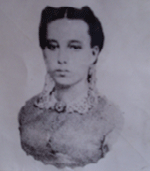3.1.8 Female voices in Cuban poetry between 1868 and 1898

Poetry and, in general, women’s literature had to travel a long road to break the patriarchal canons prevailing in society. The compositions attributed to the Marchioness Jústiz de Santa Ana in protest against the attitude of the Spanish authorities towards the Capture of Havana by the English should be taken as a starting point, not so much for aesthetic values per se as for the intrinsic challenge to the social organization fostered by men.
Gertrudis Gómez de Avellaneda was undoubtedly the most radical of Cuban women, both in her poetry and in her personal life. In both senses, she rebelled against prevailing standards and ultimately achieved social recognition. Luisa Pérez de Zambrana also excelled in poetry, but closer to the ideal of feminine behavior for her time.
These poets were precursors to the feminine cultivation of poetry, which grew and acquired greater definition in the literary scene. The verses of Mercedes Matamoros are striking, imbued with an unusual eros that constituted a defiance of the modesty that had been instilled in her sex, a period in which “submission” was considered a virtue. This author was already part of the modernist movement.
Regarding the influence of this movement on female poetry, Mirta Yáñez states: “In the fin-de-siècle decades, the literary space was already well fertile for the emergence of the modernist movement. The aesthetic propositions of romanticism were showing themselves to be exhausted, and the crisis was already knocking at its gates, with the fluttering of swans and wailing princesses. (…) In the case of the modernist poets, intimate poetry was the almost exclusive alternative for women dedicated to fine arts. The most notable of the modernist poets was Juana Borrero, who passed away prematurely. Mercedes Matamoros and Nieves Xenes should also be mentioned.”
Juana Borrero was one of the most authentic voices in lyrical poetry of this period, specifically in the first five years of the last decade of the 19th century; although she was characterized by a femininity filtered through current concepts and the modernist influence, she developed an obsessive yearning for purity.
In addition to Juana Borrero, Mercedes Matamoros and Nieves Xenes, it is worth mentioning the works of Dulce María Borrero (sister of Juana Borrero), Aurelia Castillo and Catalina Rodríguez de Morales.
Some of these poetesses will be addressed in independent sections, others did not leave behind a very prolific work but their verses still deserve to be noted, from the poem “El canto de la mendiga” (The Song of the Beggar), written by Catalina Rodríguez de Morales, the last stanzas are transcribed, illustrative of the social situation of poor women in the colonial period and how it impacted our poetry, despite the apparent lack of social apprehensions that characterized the modernist movement:
“I too once had a clear forehead,
The seductive eyes, the ivory hands,
And someone fixes his gaze on me with passion
From love snatched away, I saw him placed at my feet.
And now my fresh blush is lost
And in soul surrendered by sorrow and pain,
Without peace and without consolation, without youth or love,
I sob and implore other people’s compassion.
Unbearable torments harass me inhumanly.
My table is without bread, my home is without fire:
Pity my torments. Do you know what it is, brothers,
“To beg for bread from door to door with tears?”








